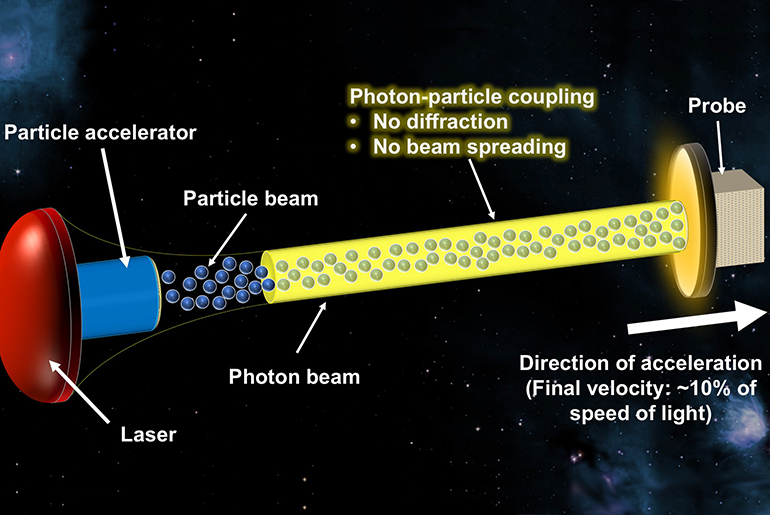
A new technology combining a laser beam and a particle beam for interstellar propulsion could pave the way for space exploration into the vast corners of our universe. This is the focus of PROCSIMA, a new research proposal by Dr. Chris Limbach and Dr. Ken Hara, assistant professors in the Department of Aerospace Engineering at Texas A&M University.
NASA has chosen the proposal “PROCSIMA: Diffractionless Beam Propulsion for Breakthrough Interstellar Missions” for the 2018 NASA Innovative Advanced Concepts (NIAC) phase 1 study. PROCSIMA stands for Photon-paRticle Optically Coupled Soliton Interstellar Mission Accelerator, and is meant to evoke the idea that interstellar travel is not so far away.
In this study, Limbach and Hara propose a new and innovative beamed propulsion architecture that could enable an interstellar mission to Proxima Centauri with a 42-year cruise duration at 10 percent the speed of light.
Proxima Centauri is the nearest known star to the sun, with Proxima b, a planet orbiting the star at a distance of 7.5 million km. The mission of the research is to create an extraordinarily long-range beam of light and matter that can propel a one kilogram probe to complete a flyby around Proxima b. There is great interest in studying this planet, as it is a prime candidate for visual observation because of its proximity to Earth and because Proxima b orbits in the habitable zone where liquid water may exist.
For half a century, researchers around the globe have been studying laser-beamed propulsion technologies for interstellar travel. In this concept, thrust is generated by the reflection of light off the spacecraft. Unlike conventional rockets, spacecraft accelerated by beams of light or matter do not require their own propellant or propulsion energy source, enabling incredibly high final velocity. The disadvantage of such concepts is that as the spacecraft gets farther away, the beams spread out, or diffract, into the vacuum of space. This results in less thrust over time as the beam pushes less and less effectively.
Limbach and Hara are looking at a revolutionary way to overcome this fundamental problem by combining the light beam with a particle beam that simultaneously reduces the spreading effects are simultaneously reduced for both beams.
The primary value of the PROCSIMA system is the game-changing, high-mass capability in the acceleration phase, provided by the greatly extended distance over which a laser can provide photon thrust. The PROCSIMA concept also maintains a tight 8-meter beam size over the entire acceleration phase, reducing the required size of the laser transmitter. An advantage of this research is that it brings together technologies developed by the fusion community, as well as aspects of photonics and telecommunications.
“One of the exciting parts of this project is that it brings together the forefront of so many different research areas, which are under intense investigation,” said Limbach. “My hope is to have an influence on all of the various topics, even if the application, which is interstellar travel, is probably decades in the future.” “This project is not only interesting because of the innovative propulsion concept but also from the perspective of fundamental physics related to particle-photon interaction,” Hara adds. “Collaboration between experiments, theory, and computer simulations is necessary to tackle this challenging problem.”
The goal of NIAC phase 1 will be to determine the potential benefits and stumbling blocks of this new concept, and to assess where relevant technologies are now. While Limbach will undertake experiments and modeling of the light beam propagation, Hara will contribute detailed calculations on the particle beam and combined beam concept. Initial modeling will be based on the state-of-the-art high energy laser technology at different wavelengths and the current capabilities of neutral particle beam sources.
The phase 1 study lasts for nine months with a grant of $125,000. After phase 1, they will apply for phase 2, which would fund a more detailed investigation of the mission architecture with a grant of up to $500,000 over a span of two years.
“One aspect of this project is simply the excitement and potential to inspire others to take a serious look at this innovative concept,” Limbach said. “Interstellar travel is an exciting and difficult problem, and if we can get this solution to work it opens up not just sending microscopic payloads to the stars, but actually sending larger, perhaps human-scale types of missions.”
The NASA Innovative Advanced Concepts Program nurtures visionary ideas that could transform future NASA missions with the creation of breakthroughs — radically better or entirely new aerospace concepts — while engaging America’s innovators and entrepreneurs as partners in the journey. The program seeks innovations from diverse and nontraditional sources and NIAC projects study innovative, technically credible, advanced concepts that could one day “change the possible” in aerospace.
